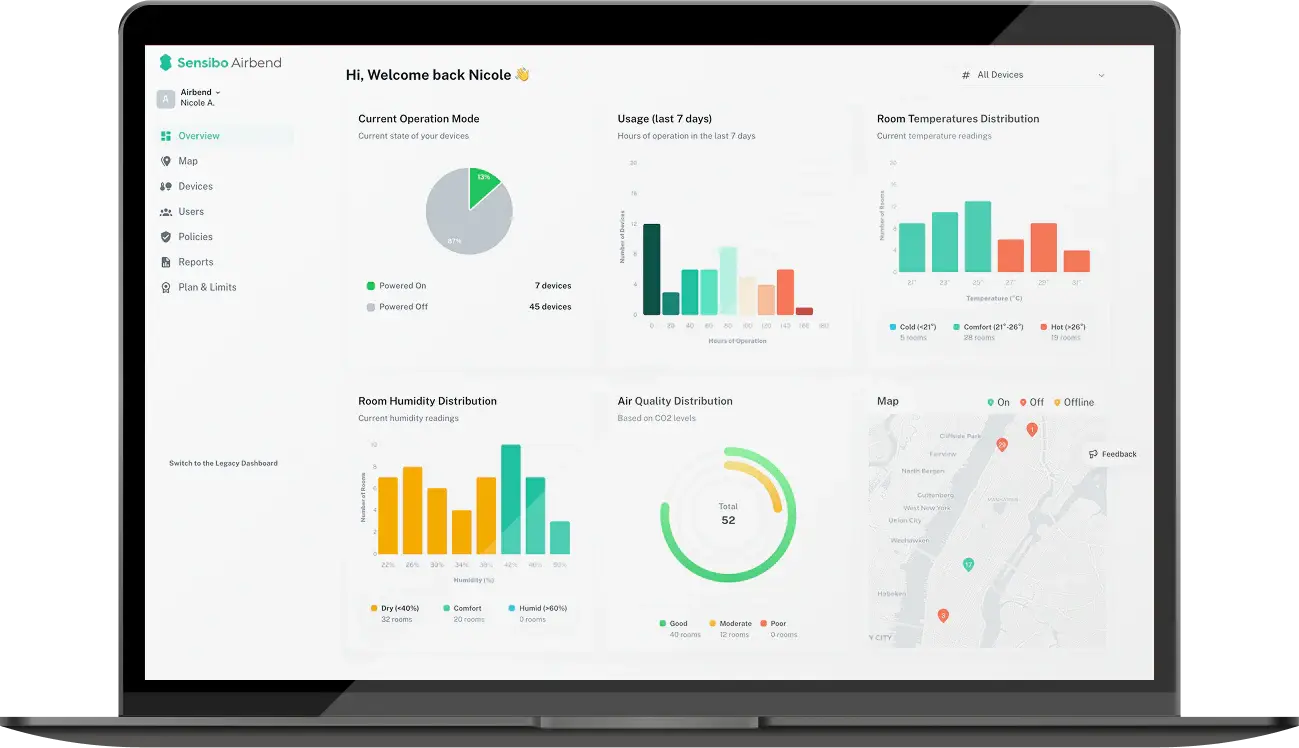Why is Air Quality Worse at Night? Scientific Explanation
Not only a daytime problem, air pollution sometimes gets worse after sunset, compromising both indoor and outdoor air quality. You are not imagining it if you have ever woken up, choked, or observed a stale atmosphere at night. Declining air quality at nighttime results from changes in temperature, atmospheric pressure, and trapped pollutants, as well as from other factors.
This can cause allergies, throw off sleep, and endanger long-term health. Many homes thus look to indoor air quality monitors to track pollutants and enhance conditions while they relax.
Air Quality and Its Daily Variations
Air quality changes throughout the day, shaped by both natural forces and human activity; it is not constant. While evenings may feel heavier and more polluted, mornings can offer clear, fresh air. This variation arises from the fact that air pollution is influenced by the movement and changes in the air itself, in addition to what is being released into the atmosphere.
Daytime: The Dispersal Effect
During the day, the combination of sunlight, rising temperatures, and increased wind speeds helps disperse pollutants. Warm air rises, carrying contaminants away from ground level, while wind currents break up concentrated pollution pockets. This is why urban areas, despite heavy traffic and industrial emissions, often experience better air quality during peak daylight hours.
Nighttime: The Accumulation Effect
As the sun sets, the atmosphere undergoes a shift. Temperatures drop, winds die down, and the air near the ground becomes more stagnant. Without the heat-driven air circulation of daytime, pollutants settle closer to the surface, leading to worsening air quality. This is especially noticeable in cities, where emissions from cars, factories, and households linger in the lower atmosphere instead of dispersing.
The Role of Human Activity
Beyond natural patterns, human activities amplify these daily fluctuations. Daytime emissions from traffic and industry contribute to overall air pollution, but these pollutants often dissipate with atmospheric movement. At night, when emissions continue—such as from heating systems, nighttime transportation, and industrial operations—they accumulate more easily due to the lack of dispersal mechanisms.
This constant cycle of dispersion and accumulation means that air quality is a dynamic, ever-changing factor. But what specific atmospheric processes make night air quality particularly poor? Let’s explore further.
.jpg?width=800&height=400&name=181489%20(1).jpg)
Temperature Inversions as a Key Factor
One of the biggest reasons air quality in the morning often feels worse than in the afternoon is a phenomenon called temperature inversion. This atmospheric effect plays a crucial role in nighttime pollution buildup, especially in urban areas.
What is a Temperature Inversion?
Under normal conditions, the air near the ground is warmer than the air above it. This warmth helps pollutants rise and disperse throughout the atmosphere. However, at nighttime, the situation flips: as the sun sets, the ground cools rapidly, and the air closest to the surface becomes colder than the air above it. This forms a stable layer of warm air that acts like a lid, trapping pollutants—including smog, vehicle emissions, and industrial byproducts—close to the ground.
How Inversions Worsen Air Pollution
With nowhere to go, pollutants accumulate in this stagnant lower layer, leading to poor air quality in the morning when people wake up to air that feels heavy and polluted. Until the sun rises and warms the ground again, breaking the inversion, this trapped pollution lingers—causing irritation for those with respiratory conditions and making urban environments feel particularly smoggy at dawn.
Where and When Are Inversions Most Common?
While temperature inversions can occur anywhere, they are more frequent and severe in specific conditions:
- Geographical Factors – Valleys and basins (like Los Angeles or Mexico City) are particularly prone to inversions because surrounding mountains can further trap air pollution.
- Seasonal Influence – Inversions are more common in winter when nights are longer, and the ground loses heat more quickly.
- Weather Conditions – Clear, calm nights with little wind create the perfect conditions for an inversion to form, allowing pollution to settle rather than disperse.
Because nighttime inversions significantly impact air quality in the morning, they are a major reason why pollution levels often peak overnight and in the early hours of the day.
Next, we’ll explore another major nighttime air quality factor: wind and its role in dispersing pollutants.
Lower Wind Speeds at Night
The wind is among nature's most efficient air cleaners. During the day, it constantly moves and dilutes pollutants. But nightfall brings a change in the surroundings: air movement slows, wind speed decreases, and pollutants settle closer to the ground. Especially in cities where pollution sources are more concentrated, this lack of circulation is a main factor aggravating air quality.
Why Does the Wind Slow Down at Night?
The sun heats the ground during the day, creating rising air currents that assist in wind generation. But these convection currents fade at night as the ground cools. The outcome is that calmer winds that fail to efficiently distribute pollutants let smog, smoke, and airborne toxins build up close to the surface.
Stagnant Air and Pollution Buildup
Worsening air quality is unavoidable, given little to no wind to carry pollutants away. Common pollutants, including vehicle exhaust, industrial emissions, and even naturally occurring dust and pollen, stay caught in the air we breathe. In cities especially, tall buildings can obstruct airflow, generating "pollution pockets" that linger until morning.
The Impact on Indoor Air Quality
Reduced wind speeds don’t just affect outdoor pollution—they also influence indoor air quality. With stagnant outdoor air, there’s less natural ventilation, meaning pollutants that seep inside—from traffic fumes to cooking byproducts—have nowhere to go. Without proper air circulation, homes can become trapped with stale, polluted air, making nighttime an especially critical period for air quality management.
The combination of lower wind speeds, pollution buildup, and restricted airflow makes nighttime air quality significantly worse than during the day.
Emission of Pollutants at Night
While the world slows down at night, pollution doesn’t stop. Many assume that because traffic eases and industrial activity declines, emissions must also drop significantly. But certain pollution sources actually become more prominent after dark, contributing to deteriorating air conditions both indoors and outdoors.
Home Heating and Combustion Emissions
Home heating is among the main causes of nighttime pollution. Many homes rely on gas furnaces, wood stoves, and fireplaces—fossil fuel-based heating systems—during colder months. These systems spew nitrogen oxides, carbon monoxide, and fine particulate matter (PM2.5), all of which gather more readily at night from still air. These pollutants influence the outdoor surroundings and seep indoors, accumulating toxins in poorly ventilated areas.
Agricultural and Industrial Nighttime Emissions
Nighttime emissions in rural areas can result from agricultural operations, including controlled burns or ammonia releases from fertilizers, contributing to atmospheric pollution. Certain industrial facilities, particularly those running 24-hour production cycles, release pollutants trapped near the ground due to temperature inversions, which remain trapped overnight as well.
The Nighttime Behavior of Ground-Level Ozone
Another factor affecting air pollution at night is the transformation of ground-level ozone (O₃). Sunlight drives the synthesis of ozone, a main component of smog, during the day. But at night, without sunlight to sustain the reaction, ozone levels usually drop—only to be replaced by other dangerous pollutants, such as nitrogen dioxide and particulate matter, which remain until morning.
.jpg?width=800&height=400&name=25892%20(1).jpg)
Tips to Improve Air Quality at Night
Since we’ve discussed most of the major factors contributing to air quality, one question arises: “How do we deal with them?”
1. Use an Air Purifier in the Bedroom
An air purifier with a HEPA filter can capture dust, allergens, and fine particulate matter (PM2.5), helping to create a cleaner breathing environment while you sleep. This is especially useful if you live in an area prone to worsening air quality at night due to pollution buildup.
2. Improve Ventilation—But Be Strategic
Ventilation is key to maintaining indoor air quality, but timing matters. If outdoor pollution levels are high, keeping windows closed may be better. However, in less polluted areas, opening windows for short periods—especially when there’s a slight breeze—can help refresh indoor air. Using exhaust fans in kitchens and bathrooms can also reduce indoor pollutants without bringing in outdoor contaminants.
3. Minimize Indoor Pollution Sources
Many common nighttime habits contribute to indoor pollution without us realizing it. To keep the air clean:
- Avoid burning candles or incense, as they release fine particulates.
- Refrain from using strong chemical cleaners before bed. Opt for natural alternatives like vinegar or baking soda.
- Reduce reliance on gas stoves or fireplaces at night, as they emit carbon monoxide and nitrogen oxides.
4. Choose Low-VOC Materials in Your Bedroom
Volatile organic compounds (VOCs) from furniture, bedding, even carpets help to explain bad indoor air quality. To cut your exposure to these emissions, choose low-VOC paints, solid wood furniture (instead of particleboard), and organic cotton bedding.
5. Monitor Your Air Quality
An indoor air quality monitor tracks pollution levels, humidity, and CO₂ concentrations in real time, allowing you to make necessary adjustments. This can be especially beneficial for spotting issues like poor ventilation or high particulate levels.
Trapped pollutants, reduced wind speeds, and continuous emissions aggravate nighttime air quality while the world sleeps. Knowing these elements enables us to take control—that is, by improving ventilation, cleaning indoor air, or lowering pollution sources. Little adjustments like choosing low-emission materials or an indoor air quality monitor can greatly affect the air we breathe. Regarding fresh air, the night shouldn't be an exception, either.


































.jpg)
.jpg?height=200&name=photo_2025-01-09_18-50-29%20(1).jpg)

.jpg?height=200&name=photo_2024-01-03_18-40-13%20(1).jpg)
.jpg?height=200&name=photo_2023-12-07_19-26-30%20(1).jpg)